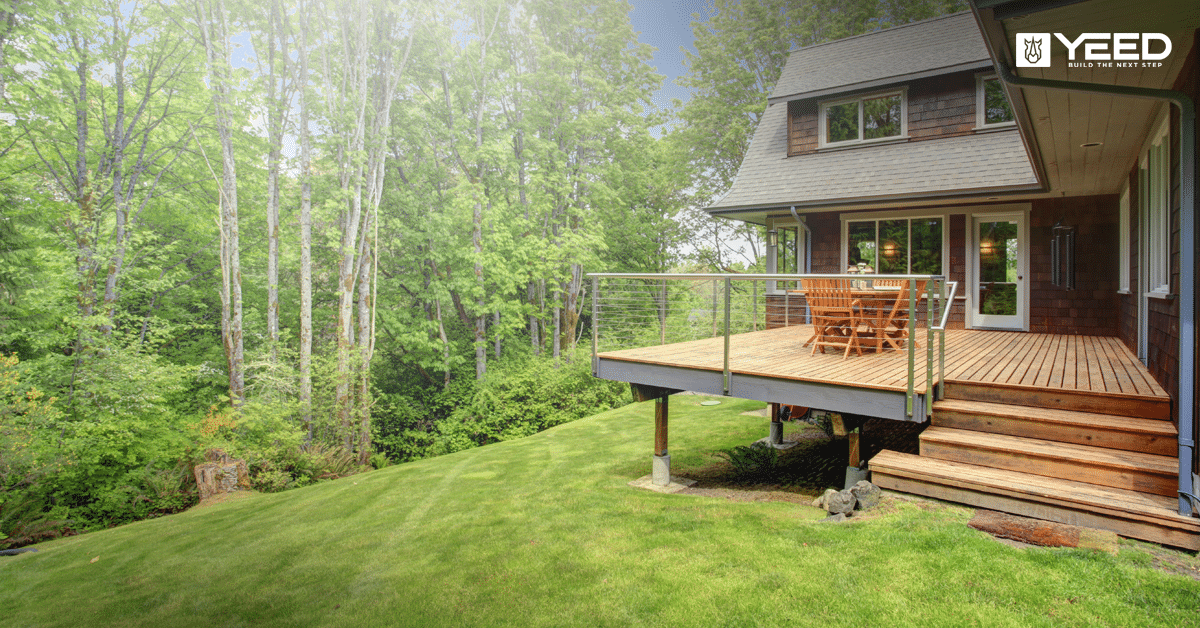What is the ideal width for a terrace?
Creating a terrace is a great way to extend your living space outdoors, allowing you to enjoy the sun and fresh air while creating a convivial space for relaxing and entertaining. However, one of the key decisions you need to make when designing your terrace is how wide it should be. Choosing the width of your terrace can have a significant impact on its usefulness, aesthetics and user-friendliness. In this article, we’ll guide you through the factors to consider when determining the ideal width of your terrace, so you can make an informed decision for your outdoor space. Read our article on terrace decoration.
Discover our brochure on laying studs
Click here
Intended use of your terrace :
The first question to ask is: what will be the main use of your terrace?
If you’re mainly planning to use your terrace for alfresco dining, you’ll need sufficient width to accommodate a table and chairs. If you’re planning more of a relaxing area with deckchairs, the width may be less.
If you want to create separate areas on your terrace, such as a dining area and a seating area, make sure you allow enough width for each zone. This will ensure that each space is functional and comfortable.
Size your outdoor space for an ideal terrace size:
Size of your outdoor space for an ideal terrace size: The size of your garden or available outdoor space plays an important role in determining the width of your terrace. A terrace should be proportional to the surrounding space to create a visual balance.
Also consider the view and surrounding landscape. If you have an unobstructed view that you want to highlight, a wider terrace with fewer visual obstacles may be preferable.

Comfort and traffic :
3.1 Easy circulation
A terrace must allow for easy, fluid circulation. Make sure your terrace is wide enough to allow people to move around comfortably without feeling cramped.
3.2 Reduced mobility
If you have family members with reduced mobility, or if you plan to use your terrace in the future, think about accessibility. Sufficient width will allow the installation of ramps or other accessibility devices if necessary.
A terrace of ideal size: a personal desire in the face of building regulations and codes
4.1 Compliance with local regulations
When considering the construction of your deck, it is essential to take into account local regulations and building codes in force in your area. These regulations vary from place to place and can have a direct impact on the size and width of your deck. It is imperative to comply with these rules to avoid potential legal problems and ensure the safety of your project.
4.2 Distance requirements
Local building codes may impose specific distance requirements between your deck and property lines, existing structures such as the house itself, or neighboring property lines. These requirements are intended to ensure that your deck does not adversely affect the safety and well-being of yourself, your neighbors and your surroundings.
4.3 Building permits
In many regions, the construction of a large terrace or a terrace attached to the house requires a building permit. Local authorities may require plans, inspections and fees to issue a building permit. Don’t overlook this crucial step, as building a terrace without a permit can result in costly penalties and delays. Find out more on the state public service website.
Choosing the ideal width for your deck is a crucial step in creating an outdoor space that meets your needs and harmoniously matches your surroundings. By carefully evaluating your intended use, the size of your outdoor space, comfort and aesthetics, you’ll be able to make an informed decision.
Remember to comply with local regulations and consult qualified professionals to help you navigate this complex process. By designing a terrace with the right width, you not only ensure a functional outdoor living space, but also a place where you can enjoy unforgettable moments with family and friends.

